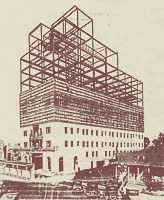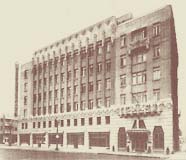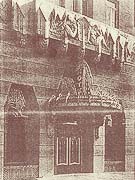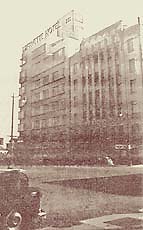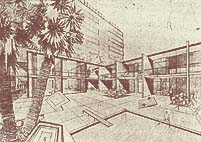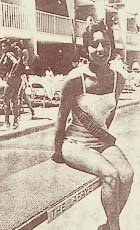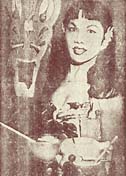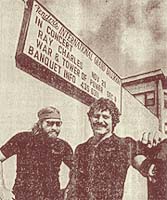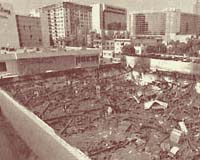History of the Lafayette
October 3, 1922
City of Long Beach to buy Southern Pacific property from Linden to Alamitos, and from Broadway to alley south, for park and city auditorium.
December 11, 1927
The 82-unit Campbell Apartment House, nearing completion at 130 Linden Avenue, is part of $10.8 million building boom in Long Beach.
Circa 1928
The Campbell Apartment Building is completed and furnished at a total cost of almost $700,000. Built and owned by E. R. Campbell, local capitalist, the apartments offer luxurious homes for the city's elite, providing hotel and maid services, garage and lobby attendants. The building's Spanish Baroque style is typical of the pre-Art Deco architecture of the time, with beautiful glazed cast terra-cotta ornamentation and balconies. The construction is of steel frame with reinforced concrete walls, and is 140 feet high.
December 16, 1928
Broadway Land Company to erect hotel on East Broadway at Linden. Investment of $300,000 for the five-story building (plus mezzanine and solarium tower), north of the Campbell Apartments and across the street from the new Broadlind Hotel. Hotel will have 100 rooms and six stores on the ground level.
April 28, 1929
Hotel de Cota (later named Lafayette) to open July 1. The name was chosen as a memorial to the first Spanish owner of the site on which the building is located.
October 27, 1929
Hotel Lafayette will open Monday, October 28 at 7am. Breakfast to be served at hotel cafe.
Designed by Arthur and Cecil Schilling, masters of the Art Deco style, the Lafayette's facade features monumental Italian stylized male and female figures, winged ram's head, hanging garlands and a wrought iron marquise with a neon sign. The Lafayette Cafe on the Broadway side is striking with an all-marble store front. The hotel was and is considered one of the finest examples of Art Deco architecture in the city.
December 31, 1930 (Advertisement)
"When in Long Beach, stop at the Lafayette Hotel, the home of comfort and refinement. Daily rates $2.50 and up."
October 22, 1931
Broadway Land Company sells Lafayette Hotel to developer H. J. Tremain for $350,000. $25,000 in improvements planned; four bungalows to be constructed on roof.
C. 1948
Broadway Building constructed as part of $1.5 million Lafayette Hotel expansion. Designed in the International Style by Los Angeles architect Theodore H. Criley. Other additions/ improvements included the Lafayette supper club, grill and cocktail lounge, and an auto port for 75 cars.
February 3, 1952
Hilton Hotels Corp. buys the Lafayette Hotel, the new annex (the 1948 Broadway addition), and the Campbell Apartments for $2 million. The buildings are joined to become one large hotel complex.
March 1, 1956
Lafayette Hotel to build addition for $400,000. 51 deluxe lanai rooms, palm garden and heated swimming pool to be erected behind hotel on parking area. Killingsworth, Brady and Smith Architects. Pool area holds 300 persons for "fashion shows, luaus or chuck wagon dinners."
December 25, 1956
International Ballroom built on former Lafayette garage. Ballroom is largest banquet facility west of Chicago at 17,500 square feet. Holds 1,500 dining guests or 2,000 meeting attendees, and has 2,500 square foot dance floor.
June 6, 1957
City Council hears prolonged special session of testimony by dentists, oral surgeon, to halt closure of alley known as Alta Way between Atlantic and Linden. Hotel planning to construct breezeway connecting to the newly constructed ballroom to the south.
January 2, 1958
Hotel expands with three cocktail lounges and dining spots: Ivanhoe Room has medieval splendor of King Arthur's court with tunnels, torture chambers, fireplaces, shields and lances; steaks, seafood, cocktails and piano bar. Outrigger Room off Broadway entrance has South Seas tropical decor, exotic drinks, "Polynesian" waitresses, Cantonese appetizers and dinners. Gaslight Room on corner of First and Linden has Roaring 20s theme with banjo and piano music by TV personality Jad Paul. Fife and Drum has Revolutionary War period decor, lunch buffet.
April 15, 1960
$100,000 redesign of lobby, foyer, dining rooms and coffee shop in preparation for International Beauty Congress. 1958-59 work involved redecoration of guest rooms, new elevators.
October 21, 1960
Hotel modernization continues with two dining rooms being remodeled. Mocha room has walnut paneling, brass trim. Red Velvet room has Czechoslovakian chandeliers, dance floor. Hotel contains network of seven dining areas. Background music plays in dining areas, lobby, elevators and Lanai swimming pool deck area.
March 15, 1962
Winning Rose Bowl teams stay at Lafayette during training. Hotel seen as good-luck charm for two years, as NFL teams including Washington Huskies and Baltimore Colts credit hospitality with Bowl wins.
August 8, 1967
Lafayette to suspend hotel operations, convert to residential apartment hotel. Reacquired by Campbell family, who will manage. Conventions into 1970 cancelled or transferred to other facilities. Refurbishing to attract young executives.
C. 1968
Lafayette converts to condominiums. First building on West Coast to do this.
February 1981
Panorama Room on 11th floor becomes home to Krause couple. Room was supper club, big band dance floor, special occasion room. Purchased by the Krauses in 1979 and remodeling finished after five months.
C. 1985
John Fender, then owner of International Ballroom, which was used as a concert hall for live bands, has plans for Lafayette rooms. Fender has problems with Homeowners Association; he has not paid monthly assessments due to disputes.
July 14, 1986
Long Beach moves to shut down bars in cocaine deals involving Players Sports Club at 144 Linden owned by Fender. Undercover officers purchase coke from five Players employees.
C. 1987
Lafayette complex designated a Historic Landmark by City of Long Beach. At same time, property is deteriorating and demolition is possible.
March 28, 1989
Fenders Ballroom declared nuisance by neighbors. Lafayette condo owners angry about noise, drunks, gun shots, mini-riot and fire last Spring. City shuts down Ballroom later that year.
September 24, 1990
City sues LAHO for failure to comply with seismic and fire codes. Lafayette owners must raise at least $3 million to bring deteriorating building up to code. Owners must pass revised CC&Rs in order to have a successful vote for the rehab.
November 5, 1990
Lafayette homeowners assesses themselves $3.5 million to fix building; LAHO hires Villa Riviera renovation project manager David Schlemmer.
July 9, 1992
Landers-Big Bear earthquakes motivate owners of historic Long Beach apartments to fix buildings. City issues $17.4 million in bonds to help owners upgrade 150 buildings.
July 14, 1992
Shaw Properties option runs out; owner Ed McMahon plans to re-open Ballroom for banquets, weddings and private events. Ballroom was closed in 1989 by City due to complaints. Plans were on hold for two years because former owner Fender paid no rent, then went into bankruptcy protection. After declaring bankruptcy, Fender was convicted of embezzlement of $141,000 from Farmers and Merchants Bank.
November 2, 1992
After a public auction, Millie Hughes regains business units bought by Fender in 1984. These include Ivanhoe Room, Fife and Drum and Players Bar, plus kitchen, bar and banquet rooms in Lafayette.
February 1, 1993
City Council creates East Village Arts District. Plan calls for art galleries, boutique retail and restaurants along with multi-family housing.
C. 1994
International Ballroom operator Mike Dixon must curfew parties by 10pm due to noise complaints from Lafayette homeowners.
January 1994
Lafayette receives special award from the Coalition for Historic Long Beach for renovation and restoration of exterior and interior.
June 7, 1994
The third fire in eight months destroys International Ballroom.
January 7, 2001
Lafayette solarium featured in story about downtown historic buildings' solaria. Many 20s-era residential high-rises are back in vogue, residents said, with prices increasing twofold in as many years. "These high-rises in Long Beach are a very unique building type", City Historic Preservation Officer Ruthann Lehrer said. "There's not another Southern California city that has these."
December 31, 2001
The Lafayette receives an honorable mention from the Long Beach Planning Commission's "Building a Better Long Beach" design awards program.
C. 2003-04
A 69-room Best Western Hotel under construction on the corner of First and Linden, at the site of former law office and parking lot (previously International Ballroom site).
August 28, 2001
Long Beach Redevelopment agency proposes lending $450,000 to Lafayette Association of Homeowners (LAHO) to convert building's unused banquet/wedding chapel area into eight rental live/work loft spaces for artists.
C. 2004
LAHO turns down Redevelopment Agency proposal and bids out loft project to private contractors/developers. Plan is to sell the units once they are constructed.
C. 2004
Four-story condominium complex with street level retail and subterranean parking to be constructed on the lot directly across the street from Lafayette. Lafayette owners purchase parking spaces in the soon-to-be-built complex.
Text and photos excerpted from local newspapers and other uncredited research sources.
|


